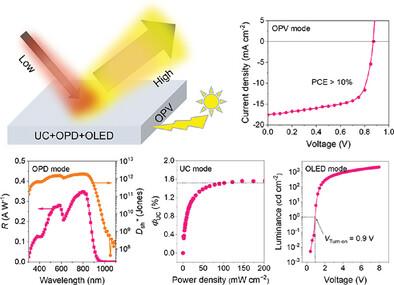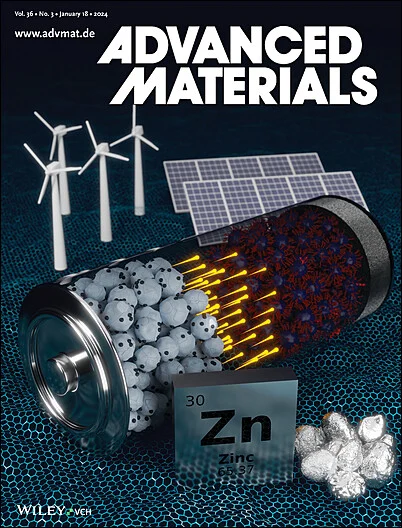Weak Near-Infrared Light Visualization Enabled by Smart Multifunctional Optoelectronics
IF 27.4
1区 材料科学
Q1 CHEMISTRY, MULTIDISCIPLINARY
引用次数: 0
Abstract
Visualizing weak NIR light is critical for sensing, imaging, and communication, but remains challenging due to inefficient detection and upconversion (UC) mechanisms. A smart NIR-to-visible photon-UC organic optoelectronic device is reported that integrates photodetection, light-emitting diode (LED), and photovoltaic capabilities to enable clear visualization of weak NIR light. The programmable device has continuous photodetection monitoring of the incident NIR intensity. When the incident intensity falls below a preset threshold, the LED function is automatically triggered to compensate for the UC emission, amplifying the visualization. The smart multifunctional device uses a carefully designed ternary bulk heterojunction sensitizer doped with rubrene:DBP as the emitter. It demonstrates high UC efficiency (>1.5%) for upconversion from 808 to 608 nm, allowing NIR visualization without external power under strong illumination. It also shows excellent NIR photodetection with photoresponsivity of 0.35 A W−1 at 800 nm and specific detectivity reaching 10¹2–10¹3 Jones, enabling sensitive detection under low-light conditions. It also exhibits a low turn-on voltage (0.9 V) and luminance exceeding 1200 cd m−2 at 5 V, ensuring energy-efficient light compensation. Furthermore, it achieves >10% power conversion efficiency, enabling sustainable self-powered operation. This multifunctional, high-performance system offers great potential in sensing, energy harvesting, and display technologies.

求助全文
约1分钟内获得全文
求助全文
来源期刊

Advanced Materials
工程技术-材料科学:综合
CiteScore
43.00
自引率
4.10%
发文量
2182
审稿时长
2 months
期刊介绍:
Advanced Materials, one of the world's most prestigious journals and the foundation of the Advanced portfolio, is the home of choice for best-in-class materials science for more than 30 years. Following this fast-growing and interdisciplinary field, we are considering and publishing the most important discoveries on any and all materials from materials scientists, chemists, physicists, engineers as well as health and life scientists and bringing you the latest results and trends in modern materials-related research every week.
 求助内容:
求助内容: 应助结果提醒方式:
应助结果提醒方式:


